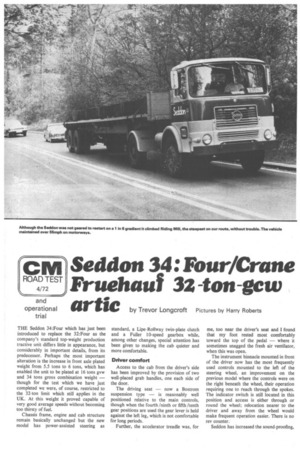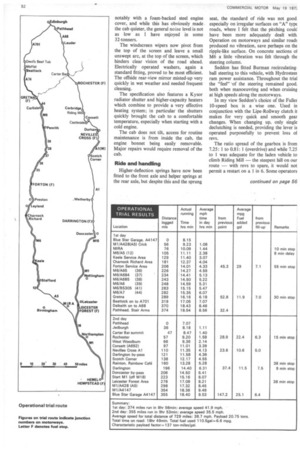THE Seddon 34:Four which has just been introduced to replace
Page 52

Page 54

Page 58

If you've noticed an error in this article please click here to report it so we can fix it.
the 32:Four as the company's standard top-weight production tractive unit differs little in appearance, but considerably in important details, from its predecessor. Perhaps the most important alteration is the increase in front axle plated weight from 5.5 tons to 6 tons, which has enabled the unit to be plated at 16 tons gvw and 34 tons gross combination weight — though for the test which we have just completed we were, of course, restricted to the 32 ton limit which still applies in the UK. At this weight it proved capable of very good average speeds without becoming too thirsty of fuel.
Chassis frame, engine and cab structure remain basically unchanged but the new model has power-assisted steering as standard, a Lipe-Rollway twin-plate clutch and a Fuller 10-speed gearbox while, among other changes, special attention has been given to making the cab quieter and more comfortable.
Driver comfort Access to the cab from the driver's side has been improved by the provision of two well-placed grab handles, one each side of the door.
The driving seat — now a Bostrom suspension type — is reasonably well positioned relative to the main controls, though when the fourth/ninth or fifth/tenth gear positions are used the gear lever is held against the left leg, which is not comfortable for long periods.
Further, the accelerator treadle was, for me, too near the driver's seat and I found that my foot rested most comfortably toward the top of the pedal — where it sometimes snagged the fresh air ventilator, when this was open.
The instrument binnacle mounted in front of the driver now has the most frequently used controls mounted to the left of the steering wheel, an improvement on the previous model where the controls were on the right beneath the wheel, their operation requiring one to reach through the spokes. The indicator switch is still located in this position and access is either through or round the wheel; relocation nearer to the driver and away from the wheel would make frequent operation easier. There is no rev counter.
Seddon has increased the sound-proofing, notably with a foam-backed steel engine cover, and while this has obviously made the cab quieter, the general noise level is not as low as I have enjoyed in some 32-tonners.
The windscreen wipers now pivot from the top of the screen and leave a small unswept arc, at the top of the screen, which hinders clear vision of the road ahead. Electrically operated washers, again a standard fitting, proved to be most efficient. The offside rear-view mirror misted-up very quickly in wet weather and needed frequent cleaning.
The specification also features a Kysor radiator shutter and higher-capacity heaters which combine to provide a very effective heating system; in particular the shutters quickly brought the cab to a comfortable temperature, especially when starting with a cold engine.
The cab does not tilt, access for routine maintenance is from inside the cab, the engine bonnet being easily removable. Major repairs would require removal of the cab.
Ride and handling Higher-deflection springs have now been fitted to the front axle and helper springs at the rear axle, but despite this and the sprung seat, the standard of ride was not good especially on irregular surfaces on "A" type roads, where I felt that the pitching could have been more adequately dealt with. Operation on motorways and similar road5 produced no vibration, save perhaps on the ripple-like surface. On concrete sections ol M6 a little vibration was felt through the steering column.
Seddon has fitted Burman recirculatingball steering to this vehicle, with Hydrosteer ram power assistance. Throughout the trial the "feet" of the steering remained good. both when manoeuvring and when cruising at high speeds along the motorways.
In my view Seddon's choice of the Fuller 10-speed box is a wise one. Used in conjunction with the Lipe-Rollway clutch it makes for very quick and smooth gear changes. When changing up, only single declutching is needed, providing the lever is operated purposefully to prevent loss of revs.
The ratio spread of the gearbox is from 7.25: 1 to 0.81: 1 (overdrive) and while 7.25 to 1 was adequate for the laden vehicle to climb Riding Mill the steepest hill on our route with revs to spare, it would not permit a restart on a 1 in 6. Some operators will need a lower gear.
On the motorway 57 mph could be maintained for prolonged periods and this enabled the vehicle to complete the 729-mile trial route in one of the shortest times yet achieved, and with a completely acceptable average fuel consumption of 6.6 mpg.
The brakes on the Seddon have also received attention in the uprating, spring brake actuators now being fitted to each wheel, while the frictional area has been increased by 28sq in. This improvement is reflected in the stopping distances obtained from 20 mph and 30 mph, peak decelerations being 0.80g and 0.78g. The secondary brake returned a peak efficiency of 0.44g. The parking brake was able to hold the vehicle in both directions on a 1 in 5 gradient.
Fuel consumption The Seddon 32:Four with the Eagle
engine has been tested by CM and so lends itself to comparison with the new 34:Four. While the former was tested over the same route, there were fewer motorway sections then, so perhaps comparison of fuel consumption is not totally representative. However, a comparison over similar sections of both tests shows fuel consumption to be slightly improved. Motorway consumption of around 7.0 mpg can be expected under normal conditions; the comparatively low figure of 6.4 mpg obtained on the Darrington-Hemel Hempstead section, arose largely through trying to maintain speed against a headwind. A better fuel consumption (7.5 mpg) was obtained on Al.
The Seddon did not like maintaining 40 mph at light loads in overdrive, so 9th gear had to be selected, using a higher rpm to maintain 40 mph.
A 40ft Crane Fruehauf dual-purpose semi-trailer was used and because of the relatively light weight of the tractive unit it
was possible to carry a 20.75 ton payload which, combined with 6.6 mpg overall fuel consumption, brought the characteristic payload factor to 137.
Summing up
The Seddon 34:Four completed the 729-mile test route in one of the fastest times yet achieved by CM with a laden 32-tanner, and yet still managed 6.6 mpg overall. Compared with the earlier 32:Four the driver's conditions have been considerably improved and, as standard, the operator gets a vehicle fitted with a suspension seat for the driver, and a tractive unit trimmed to a high standard. The vehicle is certainly easy to drive, although ride characteristics fall short of some units I have experienced. When buying such a vehicle one must, remember the very competitive price: at £5750 it is almost £2000 cheaper than some of the more luxurious, and not necessarily higher powered, 32-tonners on the market.




























































































































